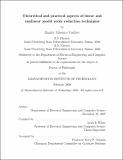| dc.contributor.advisor | Jacob K. White. | en_US |
| dc.contributor.author | Vasilyev, Dmitry Missiuro | en_US |
| dc.contributor.other | Massachusetts Institute of Technology. Dept. of Electrical Engineering and Computer Science. | en_US |
| dc.date.accessioned | 2008-11-07T14:09:22Z | |
| dc.date.available | 2008-11-07T14:09:22Z | |
| dc.date.copyright | 2008 | en_US |
| dc.date.issued | 2008 | en_US |
| dc.identifier.uri | http://hdl.handle.net/1721.1/42909 | |
| dc.description | Thesis (Ph. D.)--Massachusetts Institute of Technology, Dept. of Electrical Engineering and Computer Science, 2008. | en_US |
| dc.description | This electronic version was submitted by the student author. The certified thesis is available in the Institute Archives and Special Collections. | en_US |
| dc.description | Includes bibliographical references (p. 133-142). | en_US |
| dc.description.abstract | Model order reduction methods have proved to be an important technique for accelerating time-domain simulation in a variety of computer-aided design tools. In this study we present several new techniques for model reduction of the large-scale linear and nonlinear systems. First, we present a method for nonlinear system reduction based on a combination of the trajectory piecewise-linear (TPWL) method with truncated-balanced realizations (TBR). We analyze the stability characteristics of this combined method using perturbation theory. Second, we describe a linear reduction method that approximates TBR model reduction and takes advantage of sparsity of the system matrices or available accelerated solvers. This method is based on AISIAD (approximate implicit subspace iteration with alternate directions) and uses low-rank approximations of a system's gramians. This method is shown to be advantageous over the common approach of independently approximating the controllability and observability gramians, as such independent approximation methods can be inefficient when the gramians do not share a common dominant eigenspace. Third, we present a graph-based method for reduction of parameterized RC circuits. We prove that this method preserves stability and passivity of the models for nominal reduction. We present computational results for large collections of nominal and parameter-dependent circuits. Finally, we present a case study of model reduction applied to electroosmotic flow of a marker concentration pulse in a U-shaped microfluidic channel, where the marker flow in the channel is described by a three-dimensional convection-diffusion equation. First, we demonstrate the effectiveness of the modified AISIAD method in generating a low order models that correctly describe the dispersion of the marker in the linear case; that is, for the case of concentration-independent mobility and diffusion constants. | en_US |
| dc.description.abstract | (cont) Next, we describe several methods for nonlinear model reduction when the diffusion and mobility constants become concentration-dependent. | en_US |
| dc.description.statementofresponsibility | by Dmitry Missiuro Vasilyev. | en_US |
| dc.format.extent | 142 p. | en_US |
| dc.language.iso | eng | en_US |
| dc.publisher | Massachusetts Institute of Technology | en_US |
| dc.rights | M.I.T. theses are protected by
copyright. They may be viewed from this source for any purpose, but
reproduction or distribution in any format is prohibited without written
permission. See provided URL for inquiries about permission. | en_US |
| dc.rights.uri | http://dspace.mit.edu/handle/1721.1/7582 | en_US |
| dc.subject | Electrical Engineering and Computer Science. | en_US |
| dc.title | Theoretical and practical aspects of linear and nonlinear model order reduction techniques | en_US |
| dc.type | Thesis | en_US |
| dc.description.degree | Ph.D. | en_US |
| dc.contributor.department | Massachusetts Institute of Technology. Department of Electrical Engineering and Computer Science | |
| dc.identifier.oclc | 243864643 | en_US |
